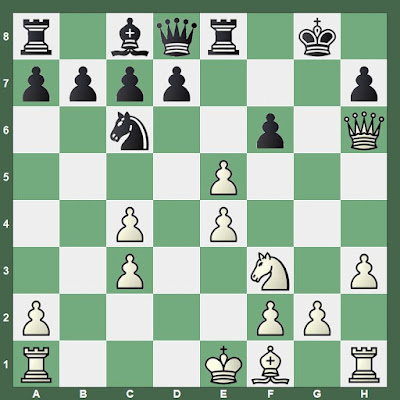I also created similar cards for the first 24 blue diagrams in the rook endgame chapter. These cards served as prompts for some endgame lessons with some young chess students during the spring break chess camp earlier this month (see "Stockfish's Curve Ball"). My difficulty with some of the positions convinced me that it was time to revisit the rook chapter of Dvoretsky's Endgamne Manual.
I do not disagree with those who opine that the book is not aimed at players of my strength. However, I must insist that it depends on how you read. It might take me a month or longer to get through the 24 blue diagrams (now gray in the fifth edition [2020], the one revised by Mūller after Dvortsky's death). Some of my lessons with a student the past year had us working thorough all of the rook endings in Jesus de la Villa, 100 Endgames You Must Know, 4th ed. (2015) and then I worked through all the positions in Thomas Engqvist, 300 Most Important Chess Positions (2018)., which included a fair number of challenging rook endings. I believe that I'm ready for the advanced work in Dvoretsky.
I do not expect to get through the entire chapter on rook endgames. For the time being, however, I am pushing through carefully and slowly. Some days I study one or two positions. I read Dvoretsky's analysis and then practice many of the positions against Stockfish.
Tuesday, I worked on exercise 9/4. First, I studied the diagram. Then, I set it up on my iPad and studied it longer. The clock started when I made my first move.
Playing against an engine usually presents information that play against humans never reveals. The engine presents its evaluation of the position.
Black to move
I first considered 1...Ra6, but saw that White would force an exchange of rooks or win my pawn for no cost and leave me in a hopeless position of passive defense against a passed f-pawn.Then, I considered putting my rook behind the king or the pawn, but saw that would fail.
The key was understanding that my king needed to move to the short side.
1...Kf8!
At first Stockfish on the iPad gave the evaluation as 2.6, but that quickly dropped and after several seconds, settled at 0.1. I knew my move was correct.
2.Rb6 Ra1 3.Rxf6 Kg8
Short side is the only move that holds.
4.Re6 Kf8
Rg1+ is also okay. Occupation of the promotion square should be sought when possible, moving to the short side when forced by checks or mate threats.
5.Rb6 Rf1
Alternately, Black can play 5...Rg1+ 6.Kf6 Kg8
6.Rb8+ Ke7 7.Rb7+
The point of 5...Rf1 was that f6+ would be met with Rxf6+.
8.Rb2
Matters remain critical: Black must hold the rook on the f-file, move the king to e7 again, or throw in a check that leads to a mate threat and then retreat to the short side.Rg1+ is also okay. Occupation of the promotion square should be sought when possible, moving to the short side when forced by checks or mate threats.
5.Rb6 Rf1
Alternately, Black can play 5...Rg1+ 6.Kf6 Kg8
6.Rb8+ Ke7 7.Rb7+
The point of 5...Rf1 was that f6+ would be met with Rxf6+.
8.Rb2
Black to move
8...Rf3 9.Rb8+ Kf8 10.Rb7+ Kf8 11.Rf7+ Kg8 12.Rg7+
Black to move
This move holds, but the defense might be easier after 12...Kf8. For instance, 13.Rh7 Rg3+ 14.Kf6 Kg8
13.Re7 Rg3+
Only move.
Only move.
14.Kf7 Ra3
Now, I was forced to return the rook to the long side.
15.Rc7 Ra1 16.Kg6
16...Rg1+Now, I was forced to return the rook to the long side.
15.Rc7 Ra1 16.Kg6
Black to move
Again, there was only one move that held.
17.Kf6 Ra1 18.Kf7
The pawn's advance can no longer be prevented, but it cannot yet advance far enough for victory.
18...Ra2 19.f6
Black to move
This move was necessary with an important idea that is revealed in the next few moves.
20.Re7 Ra3 21.Rd7 Ra2 22.Ke6+
Black to move
22...Kg6This move--a vital defensive resource--was only possible because of 19...Kh7. 22...Kh6 also holds, but I did not consider it as threatening the pawn should the king step away seems best.
22...Kg8 loses to a technique that is easy to learn. 23.Rd8+ Kh7 24.f7. With the rook controlling the promotion square, White's king deals with checks from the rear by marching towards Black's rook. When the checks run out, the pawn promotes.
23.Rd6 Re2 24.Kd5 Kf7
24...Rd2+ seems simpler.
25.Rd7+ Kxf6=
Exercise 9/5 proved more difficult. I needed quite a few take backs to find my way.
The position appears at least twice in ChessBase's Mega 2024. Dvoretsky references Rohde,M. -- Cramling,D., Innsbruck 1977, where Rohde was not successful in winning. White to move
Dvoretsky also mentions analysis of the position by Nikolay Kopaev. I am able to find this analysis in Harold van der Heijden's Endgame Study Database VI (2020), but not volume 5 of Comprehensive Chess Endings by Yuri Averbakh and Kopaev.
"White wins, but with some hard work," Dvoretsky writes (398).
Dvoretsky's Endgame Manual is indeed challenging, but it is not out of reach for a class player looking for instructive practice against the silicon beasts.




























